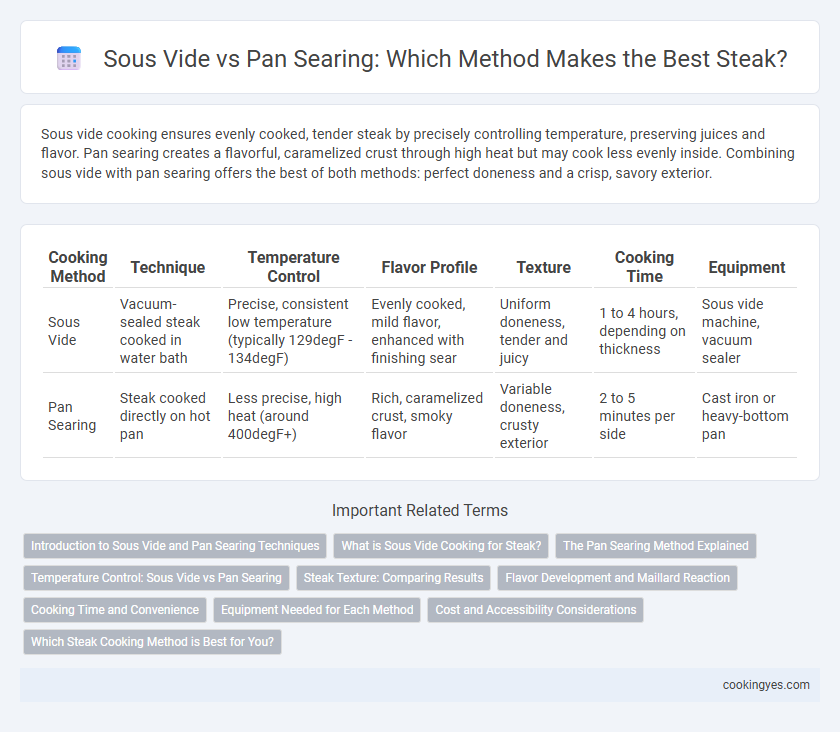Sous vide cooking ensures evenly cooked, tender steak by precisely controlling temperature, preserving juices and flavor. Pan searing creates a flavorful, caramelized crust through high heat but may cook less evenly inside. Combining sous vide with pan searing offers the best of both methods: perfect doneness and a crisp, savory exterior.
Table of Comparison
| Cooking Method | Technique | Temperature Control | Flavor Profile | Texture | Cooking Time | Equipment |
|---|---|---|---|---|---|---|
| Sous Vide | Vacuum-sealed steak cooked in water bath | Precise, consistent low temperature (typically 129degF - 134degF) | Evenly cooked, mild flavor, enhanced with finishing sear | Uniform doneness, tender and juicy | 1 to 4 hours, depending on thickness | Sous vide machine, vacuum sealer |
| Pan Searing | Steak cooked directly on hot pan | Less precise, high heat (around 400degF+) | Rich, caramelized crust, smoky flavor | Variable doneness, crusty exterior | 2 to 5 minutes per side | Cast iron or heavy-bottom pan |
Introduction to Sous Vide and Pan Searing Techniques
Sous vide cooking involves sealing steak in a vacuum bag and immersing it in a precisely controlled water bath to achieve even doneness and retain moisture. Pan searing, by contrast, applies high heat directly to the steak's surface, creating a caramelized crust that enhances flavor through the Maillard reaction. Combining sous vide with a finishing pan sear produces a tender interior with a crispy exterior, optimizing steak texture and taste.
What is Sous Vide Cooking for Steak?
Sous vide cooking for steak involves vacuum-sealing the meat and cooking it in a precisely controlled water bath at a consistent temperature, ensuring even doneness throughout. This method allows for precise control over the steak's internal temperature, resulting in tender, juicy meat without the risk of overcooking. Unlike pan searing alone, sous vide locks in moisture and enhances flavor by evenly tenderizing the steak before finishing with a quick sear for a caramelized crust.
The Pan Searing Method Explained
Pan searing steak involves cooking the meat over high heat in a hot skillet, typically cast iron, to create a flavorful, caramelized crust through the Maillard reaction. This method allows for precise control of the browning process and enhances the steak's texture and taste by locking in juices. Pan searing is favored for producing a rich, savory exterior while maintaining a tender interior, especially when paired with butter basting or aromatics like garlic and thyme.
Temperature Control: Sous Vide vs Pan Searing
Sous vide cooking offers precise temperature control by immersing steak in a water bath set to the exact target doneness, ensuring even cooking throughout the meat. Pan searing relies on high, direct heat which can lead to uneven internal temperatures but creates a flavorful crust through Maillard reactions. The method chosen significantly impacts the steak's juiciness and texture, with sous vide providing consistent doneness and pan searing enhancing surface flavor.
Steak Texture: Comparing Results
Sous vide cooking ensures a consistently tender texture throughout the steak by gently heating the meat to an exact temperature, preventing overcooking and retaining moisture. Pan searing creates a flavorful crust through the Maillard reaction, adding a crispy outer layer while maintaining a rarer interior. Combining sous vide with a quick pan sear often yields the ideal balance of tender, evenly cooked meat and a caramelized, textural exterior.
Flavor Development and Maillard Reaction
Sous vide cooking ensures precise temperature control, resulting in evenly cooked steak with enhanced moisture retention but lacks the direct high heat needed for the Maillard reaction, which creates complex, savory flavor compounds and a caramelized crust. Pan searing applies intense, dry heat that triggers the Maillard reaction, producing a rich, browned exterior packed with umami and roasted notes essential for flavor development. Combining sous vide with a final pan sear maximizes flavor by preserving juiciness while achieving the ideal crust through Maillard browning.
Cooking Time and Convenience
Sous vide cooking ensures a perfectly even temperature throughout the steak by circulating water at a precise temperature, typically requiring 1 to 3 hours, which allows for hands-off preparation and consistent results. Pan searing is much faster, taking only a few minutes per side, but demands careful timing and attention to avoid overcooking or uneven doneness. Sous vide offers superior convenience for meal prep with minimal active cooking time, while pan searing provides quick results but requires more skill and monitoring during the process.
Equipment Needed for Each Method
Sous vide cooking requires an immersion circulator and a vacuum sealer or airtight bags to maintain precise temperature control for evenly cooked steak. Pan searing demands a heavy-bottomed skillet, preferably cast iron, and high smoke point oil to achieve a caramelized crust and flavorful Maillard reaction. Both methods can be combined by sous vide cooking first, then finishing with a quick pan sear for optimal texture and taste.
Cost and Accessibility Considerations
Sous vide cooking requires specialized equipment like immersion circulators and vacuum sealers, which may present a higher initial investment compared to pan searing. Pan searing utilizes basic kitchen tools such as a skillet and stove, making it more accessible and cost-effective for everyday steak preparation. While sous vide offers precision and consistent results, pan searing remains a budget-friendly option with minimal gear requirements.
Which Steak Cooking Method is Best for You?
Sous vide offers precise temperature control, ensuring a perfectly even cook and tender, juicy steak every time, ideal for those who value consistency and don't mind investing in specialized equipment. Pan searing delivers a flavorful, caramelized crust quickly, perfect for cooks who enjoy traditional methods and a rich, savory exterior. Choosing between these methods depends on your priorities: sous vide for precision and tenderness, pan searing for speed and bold flavor.
Sous Vide vs Pan Searing for Steak Infographic

 cookingyes.com
cookingyes.com